Posted by Elena del Valle on February 28, 2014
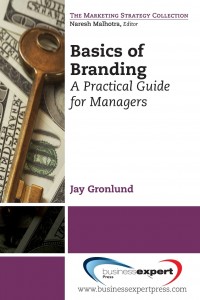
Basics of Branding
Photos: The Pathfinder Group
Not all brands are created equally. Some pass unnoticed and fade into oblivion while others linger in our minds for years or longer. What makes the difference? Powerful brands are different, compelling, and relevant enough to truly excite the minds and hearts — and wallets — of their customers. That is what Jay Gronlund, a business development consultant, believes. In his new book Basics of Branding: A Practical Guide for Managers (Business Expert Press, $43.95) he explains how readers can create an emotional connection with their customers that results in sustainable brand loyalty and steady revenue growth. The book is also available in digital format for $19.95.
“Yes, definitely. The principles behind branding are relevant for all types of businesses, big or small, product or service,” Gronlund said by email in response to a question about the relevance of branding regardless of size of the company. “Brand positioning starts with defining and thoroughly understanding your target customer. Most start-ups are preoccupied with their new product or service, and don’t pay enough attention to addressing what their potential customers want, especially from an emotional standpoint. Branding is basically about creating a relationship with a customer, and it has been proven by neuroscientists that emotions have the most influence on human behavior, including purchase decisions.”
The 194-page softcover book with tables and illustrations published in 2013 is divided into six chapters: What Is Branding Really About?; The Positioning Statement, Emotions and Brand Equity; Branding Applications; Building Strong Bonds; Branding in the B2B World, New Opportunities; Marketing Today: Branding for Digital Marketing and Social Media. Gronlund proposes that it is critical to begin with a “message or impression that forges a bond of trust with that customer.”
One thing to remember about branding? “Branding is all about forming a connection with your customer, ideally one based on experience and emotions that make that customer trust that brand,” he said by email.
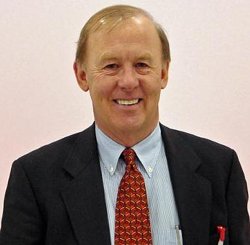
Jay Gronlund, author, Basics of Branding
When asked about developing a brand for an intangible such as an author he said: “A service, while not as concrete as a product, still requires good branding, since both must make a promise (i.e. the benefit) to a target audience, supported by credible reasons to believe this promise. Ultimately, a customer will become interested in a service, and buy it, only if they feel emotionally (and rationally) that such a service will add some value to their lives and make them more happy and satisfied. Any author, for fiction or non-fiction, should try to brand him or herself, so that the author’s (brand) name will mean something special to prospective readers. Ideally building a bond with his/her audience is based on trust, plus the expectation that each time he/she will learn and/or be entertained. The brand impression the author provides should be distinct, relevant and tailored to the unique characteristics of his/her storytelling, content/subject matter, and flair for offering something new and creative.”
Gronlund has held senior positions at Richardson-Vicks, Church & Dwight, Seagrams, and Newsweek. In 1990, he started The Pathfinder Group, a boutique business development consulting firm specializing in cross-border marketing; re-positioning brands; facilitating ideation sessions; and con- ducting workshops overseas. In 1999, he created a course on positioning and brand development for New York University he still teaches today.
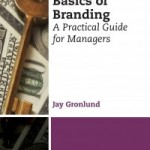
Click to buy Basics of Branding
Comments:
Filed Under: Books
Posted by Elena del Valle on February 27, 2014
Information provided by Event Partner
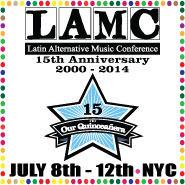
Latin Alternative Music Conference, New York City July 8-12, 2014http://www.latinalternative.com/
The LAMC (Latin Alternative Music Conference) is the only major conference celebrating and supporting genres of Latin music that are left of center and forging the way Latinos, especially young, bicultural Latinos in the U.S., define themselves. Hailed by The New York Times as the “Sundance of Latin music”, the LAMC is also the largest Latin music conference in the US.
The 15th annual LAMC will break new ground, inaugurating a new, expanded focus on a diverse array of special events dedicated to music, food, film, books, art and poetry.
Posted by Elena del Valle on February 20, 2014

Hercules before Operation Lion Ark – click image to enlarge
Video, photos: Animal Defenders International (ADI)
Animal Defenders International (ADI), a 501(c)(3) nonprofit organization registered in Delaware and California, with offices in Los Angeles, London and Bogota, campaigns on behalf of animals used in entertainment, and other industries. Recently, the organization relocated circus animals, including 29 lions, from circuses in Bolivia after that country’s legislature passed a new law banning animals in traveling circuses, and asked ADI for assistance relocating the lions abroad.
According to ADI, Bolivia’s ban on animals in traveling circuses was the result of the organization’s undercover investigation that exposed behind the scenes cruelty, and its public education campaign. While one circus surrendered the lions voluntarily eight others weren’t ready to comply initially. ADI, with the support of government representatives, pressured the circuses into turning the remaining lions into their custody.
During Operation Lion Ark in 2011, in addition to the lion seizures, the team assisted in moving six monkeys, a coati mundi, a deer and a horse. The native wild animals (monkeys, coati mundi and deer) were returned to protected wild areas.
“What I didn’t realize was that it was going to be an extraordinary story about the human spirit and what the human spirit can do when people come together,” said Jorja Fox, an actress known for her role as Sara Sidle in television show CSI who was an associate producer of Lion Ark and also appears in the film, in a press release.

Hercules after Operation Lion Ark – click image to enlarge
There were about twenty people in the ADI team that saw to the rescue and relocation of the circus animals. They were from Britain, Bolivia, Colombia, Peru and the United States. The organization filmed the activities that took place during the seven month period in which 25 of the 29 lions were seized from the circuses, rehabilitated, flown to their new home in Colorado and released in their new habitat. The result was Lion Ark, a moving film that covers the process from the ADI perspective and features interviews with investigators, campaigners, government officials and members of congress in Bolivia.
The film was separate from the relocation project and took about two and half years to complete. Scroll down to watch short video clip of Lion Ark film.
The relocation of the animals, ground and air transport, crates and the building of the animal enclosures and lion houses at sanctuaries the United States cost over a million dollars. The film budget itself was separately funded, and was about half a million dollars. Bob Barker, a well known celebrity in the United States and an animal rights advocate, funded Operation Lion Ark.
In order to provide the lion prides an experience as close as possible to what they might have had in a natural environment, they were placed in four natural enclosures (among the largest available) occupying 80 acres at The Wild Animal Sanctuary (TWAS) near Denver, Colorado.
“People sometimes ask, why bother about animals when there’s so much human suffering? But it is not a choice of one or the other. When we protect the weakest or the most vulnerable, whether it is animals or people, we all gain. That’s how we shape our world…understanding our connection with other species, and our place on this planet, is the next step in human evolution,” said Jan Creamer, president and founder, Animal Defenders International, in the film.
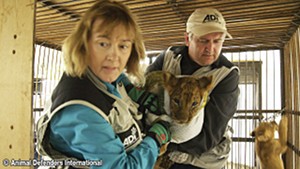
Jan Creamer and Tim Phillips of ADI and a lion cub
Since their relocation, the Lion Ark lions have been living in family prides at the Colorado facility where ADI plans to continue to fund their care for the rest of their lives, according to ADI. The new lion home was outfitted with fencing and basic safety measures as well as enrichment facilities, wooden constructions to climb and play on, hill-like mounds and underground dens, to provide a diverse and exciting space to keep the lions busy and stimulated.
Lion Ark, the film, was nominated for this year’s Image Awards of the National Association for the Advancement of Colored People (NAACP) in the Outstanding International Motion Picture category. The other five nominees in the that category are: War Witch; Call Me Kuchu; La Playa D.C.; and High Tech, Low Life.
Lion Ark Film Festival Selections include: Winner Best Documentary (Jury Award), Sun & Sand Film & Music Festival, Mississippi; Winner Audience Choice Best Documentary, San Diego Film Festival; Audience Choice Award Anchorage International Film Festival; Official Selection Raindance Film Festival, London; Official Selection Mill Valley Film Festival; Official Selection Hawaii International Film Festival; Official Selection Fort Lauderdale International Film Festival; Official Selection Virginia Film Festival; Official Selection Starz Denver Film Festival; Official Selection Irvine International Film Festival; Official Selection Beloit International Film Festival; Official Selection Sedona International Film Festival.
“We are honored to have been nominated for this award. Lion Ark is a film about respect for people and animals so we are really pleased to receive this acknowledgement,” said Tim Phillips, director, Lion Ark, in a press release. “In this film, you see the worst of humanity, but also humanity at its best. It is an empowering film that shows that people can make a difference. Lion Ark shows how animal protection is a vital part of the fabric of social justice, where human society draws a line as to what is, and is not, acceptable.”
The producers of Lion Ark hope to have the movie on general release in 2014. Once Lion Ark is purchased by movie distributors, it should become available at movie theaters, and via TV, DVD and VOD, a representative explained by email. As of November 10, 2013, Lion Ark had appeared in eight major film festivals in United States and United Kingdom.
http://www.ad-international.org/adi_usa/ (required by Animal Defenders International)
Posted by Elena del Valle on February 14, 2014
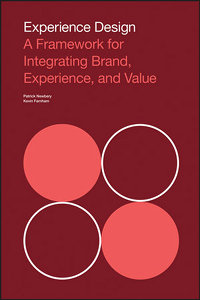
Experience Design
Photos: Wiley, Patrick Newbery, Kevin Farnham
In today’s business environment, it is necessary to support a brand through the product or service offerings across the entire lifeline of the customer relationship rather than only on the day he or she make a purchase. So say Patrick Newbery and Kevin Farnham who believe customers businesses should develop an “…understanding of how to look at opportunities, issues, strategies and tactics.” Achieving that, they argue, requires business managers and designers to collaborate and shift the way they approach their products.
“Apple’s reinvention of itself changed the world in many ways. The design of the end products and services is brilliant. But it wasn’t just how they were designed—it’s what Apple chose to design, and why, that mattered,” said Farnham, chief executive officer of Method. “Apple created value by redefining the experiences people could have with products they already wanted to use.”

Kevin Farnham, co-author, Experience Design
In Experience Design: A Framework for Integrating Brand, Experience and Value (Wiley, $32), a 232-page softcover book published in 2013, they explain their thinking. The book is divided into three sections, Context, Frameworks and Tools, and Moving Forward; and ten chapters: Thinking about Design, Thinking about Business, Thinking about Change, Thinking about Experience Design, Brand Frameworks and Tools, Product/Service Framework and Tools, Customer Journey Framework, Putting It Together, Getting Business to Act on Experience Design, and Working with Vendors.

Patrick Newbery, co-author, Experience Design
“Value drives relevance which drives engagement, which is the best way to drive revenue,” said Newbery, Method’s chief strategy officer. “The age of image as brand is closing. Trying to fix the experience at the 11th hour through brilliant design alone cannot create value that doesn’t exist.”
The authors highlight that only 25 percent of new product innovations ever reach commercial launch, and only 45 percent of those meet profit goals, resulting in an 11 percent success rate.
They’re of the opinion that experience design provides business a reason to invite design to the table earlier than is common while making it possible for executives to understand how design can help solve problems that expand past look and feel. They suggest a company and its products benefit when they invite design contributors to the conversation early on in the development process.
The authors intended audience is primarily business folks who engage design or who manage key aspects of the customer experience and need to understand how to use design more effectively to meet business goals. Their secondary audience is “design professionals who are multi-disciplinary and looking to develop their skills and understanding about how to help clients understand how to plan for and evaluate design.”
Farnham is responsible for company strategy, global recruiting, and business development at his company. In the last twenty years, according to his bio, he has worked directly with business leaders from companies Apple, BBC, Microsoft, MoMA, Nike, Google, and TED Conferences. Newbery, a resident of Berkeley, relies on his experience with strategy, brand, innovation, and design to develop the tools and frameworks that his company uses to shape client engagements.

Click to buy Experience Design
Comments:
Filed Under: Book
Posted by Elena del Valle on February 7, 2014

Peruvian Power Foods
Photos: Health Communications, Inc.
Manuel Villacorta, MS, RD, CSSD dedicated two years to researching particularly nutritious foods, traveling to his native Peru to connect with chefs, farmers, food bloggers, fishermen, and people in general about that country’s indigenous foods. As part from his journey of discovery the dietician with 16 years of experience created 100 recipes and took 2,000 photos many of which are featured in Peruvian Power Foods: 18 Superfoods, 101 Recipes, and Anti-aging Secrets from the Amazon to the Andes (Health Communications, Inc. $18.95), a 310-page paperback book he wrote with the help of coauthor Jamie Shaw, a writer, branding specialist and recipe creator. The recipe examples include breakfast granola with lucuma, white bean hummus with sacha inchi, pichuberry muffins, maca shake, and truffles with cacao and camu camu.
“The reception has been great. Peruvian cuisine is a hot topic at the moment,” Villacorta said by email in response to a question about the public acceptance to his new book published October 2013. “Chefs are heralding the cuisine with the enthusiasm they once reserved for France. Peruvian restaurants are popping up in major cities everywhere. On his Parts Unknown program, Anthony Bourdain dubbed Peru’s cuisine one of the most underrated in the world. Clearly, something was happening in my home country. And while it’s partially due to the innovative preparations and exciting cross-cultural dishes being developed, Peru is also home to thousands of foods found nowhere else on the planet, many of which are staggering in their content of potent nutrients. As a native Peruvian, I felt there was no better time than the present to share my knowledge about the foods that originate from the region. And as a registered dietitian, I was interested in the health properties of these foods. This book helped me marry the two, health and cooking.”

Manuel Villacorta, MS, author, Peruvian Power Foods
The book highlights 18 foods believed to be particularly high in nutrient value. They are pichuberry, maca, cacao, kiwicha, avocado, aji, camu camu, purple corn, artichokes, sacha inchi, lucuma, beans, purple potatoes, cilantro, papaya, yacon, quinoa, and sweet potatoes. Each food section features nutritional aspects, culinary uses, and recipes.
“Yes. Moreover, I’m especially finding the Latino population to be very receptive, and have been asked on many occasions, if the book will be translated into Spanish,” the nutritionist said when asked about the popularity of the book among immigrant families.
While some like artichokes, cilantro, sweet potatoes, beans and avocado are easy to find many others are not prevalent in supermarkets. Fresh pichuberries, for example, seem particularly challenging to find. In Appendix B and by email in response to a question about how to purchase the ingredients for the recipes he said: “Latino markets and/or regular supermarkets like Whole Foods, Trader Joe’s, Safeway, and Vons. Brands used in the book were Sacha Vida, Navitas, Barry Farm, and Bobs Red Mill.”
Villacorta is also author of Eating Free: The Carb-Friendly Way to Lose Inches, Embrace Your Hunger, and Keep the Weight off for Good. He served as a national media spokesperson for the Academy of Nutrition and Dietetics. He is a health blog contributor to The Huffington Post, an on-air contributor to Univision, and a health and lifestyle contributor for Fox News Latino. He owns a San Francisco-based private practice.

Click to buy Peruvian Power Foods
Comments:
Filed Under: Books
Posted by Elena del Valle on February 5, 2014
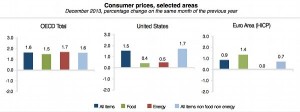
Consumer prices, selected areas December 2013, percentage change on the same month of the previous year – click to enlarge
Image: Organization for Economic Co-operation and Development (OECD)
Annual inflation rose in the United States to 1.5 percent up from 1.2 percent, according to Organization for Economic Co-operation and Development (OECD) figures released this week. In Canada, the change was 1.2 percent in December 2013 up from 0.9 percent in November 2013 while in Germany it went to 1.4 percent up from 1.3 percent; and Japan it went to 1.6 percent up from 1.5 percent. It remained at 0.7 percent in France and Italy and dropped in the United Kingdom to 2 percent down from 2.1 percent. The overall Euro area annual inflation increased to 0.9 percent in December, compared with 0.8 percent in November.
In the OECD area, consumer prices went up by 1.6 percent in the year to December 2013, compared with 1.5 percent in the year to November 2013. This minor increase in the annual rate of inflation was driven for the most part by energy prices which increased by 1.7 percent in the year to December, compared with stable prices in November. The annual price inflation of food was steady at 1.5 percent in December. The OECD annual inflation rate excluding food and energy was also stable at 1.6 percent in December.
The OECD tracks changes in developed countries and provides a forum for member governments to compare policy experiences, search for answers to common problems, identify good practices and coordinate domestic and international policies.
























